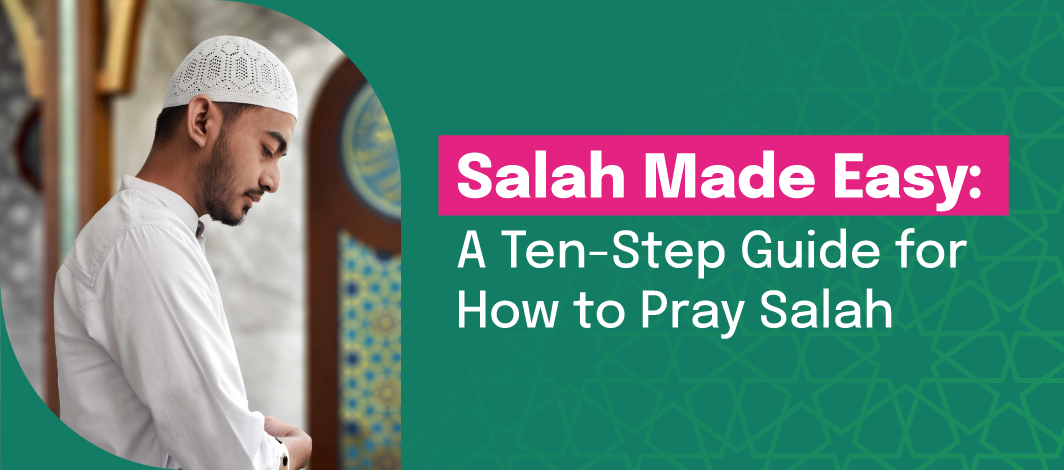As one of the five pillars of Islam, praying Salah is one of the most important parts of everyday life for a Muslim. It’s compulsory to perform Salah five times a day for everyone of age and is a beautiful way to communicate and feel close to Allah SWT.
If you’re new to Islam or haven’t performed Salah before, this quick ten-step guide will give you all you need to feel more comfortable to pray Salah and build your relationship with Allah.
Do keep in mind, however, that this is just a simple guide. There are variations to Salah depending on which Salah and how many Raka’at you’re performing, so do be sure to look up any differences if you’re not sure.
Ten-Step Guide to Performing Salah
Step One: Preparation Is Key
It’s important to prepare for Salah. Set aside some time to set an alarm on your phone so you don’t miss any of the five daily prayers.
Firstly, you need to be in a state of purification (wudu) before wearing clothes to cover your awrah; men should cover themselves from their abdomen to knees, while women should cover everything except their hands, feet and face.
You should find a nice clean space to perform Salah, perhaps opting to use a prayer mat, and ensure you won’t be disturbed.
Step Two: Face Qibla
When performing Salah, you need to ensure you’re always facing the direction of the Ka’bah. So check precisely which direction it is depending on where you are in the world. For example, in the UK, Muslims should face South-East. Feel free to use an app or a compass to make sure you’re facing the right direction.
Step Three: Make Niyyah
Once you are set up and facing the qibla, start your Salah by making your intention (niyyah) to finish wudu and enter a true state of purification. It’s up to you how to make niyyah: it can either be said out loud or silently in your head; in Arabic or in your own language.
Step Four: Enter a State of Ihram
When you are ready to start Salah, raise your hands and say “Allahu Akbar,” meaning “God is the greatest” in English. Men should raise their hands up to their ears while women raise their hands up to their shoulders.
At this point, you are in a state in which nothing should distract you and your sole focus should be on praying to Allah.
Step Five: Begin Reciting for Salah
Reciting is a large part of performing Salah. Men place their right hand over their left on their abdomen while women place their hands over their chest and begin reciting Sana:
“Subhanaka Allah humma wa bihamdika, wa tabaraka ismuka, wa ta-‘aala jadduka, wa la ilaaha ghairuk.”
“O Allah, praise and glory be to you. Blessed is Your Name, and exalted is Your Majesty. There is no God but You.”
This is then followed by reciting Ta’awadh and Tasmiah:
“Auudhu bi Allah I mina ashaitan irrajeem.”
“I seek Allahs’ protection from the condemned Satan.”
“Bismillah irrahmani raheem.”
“In the name of Allah, the most gracious and merciful.”
Step Six: Recite Surahs
Continue Salah by reciting the Surah al-Fatihah before reciting another verse from the Qur’an. It’s entirely up to you which one you choose. You have to read at least three verses or one long one that’s equivalent to three shorter verses.
Step Seven: Bow Down to Allah
After reciting your surah, say “Allahu Akbar” as you bow into the Ruku position with your hands on your knees and back straight.
Say “subhana rabbiya al-azeem” three times before straightening back up and saying “Samia Allahu liman hamdiah” three times as well.
Step Eight: Prostrate
After saying “Allahu Akbar” once more, get into the Sujud position with your face, palms and knees all touching the floor and say “subhana rubbiyal a’alaa” three times.
Sit up as you say “Allahu Akbar” again and get into a sitting position. Return to the Sujud position before standing up once more, making sure to say “Allahu Akbar” each time you change position.
Step Nine: Recite Tashahud
Return to the sitting position mentioned earlier and recite Tashahud:
“Attahiyatu lil Allah, was-salawaatu wat-tayyibaat. Assalamu’alayka aiyohan nabiyyu wa rahmatu Allah wa barakaatu. Assalamu’alayana wa’alaa ‘ibaadi-llahi saliheen.”
“All greetings, prayers and good deeds are for Allah. Peace be upon you, O Prophet, and the mercy of Allah and His blessings. Peace be upon us and upon us and the righteous servants of Allah.”
Then, while keeping your hand on your knee, raise just the index finger of your right hand as you continue reciting:
“Ashhadu alla ilaaha illa Allahu wa ashhadu anna Muhammadan ‘abduhu wa rasooluh.”
“I bear witness that there is no God but Allah and that Muhammad is His servant and messenger.”
Step Ten: Do Salaam
To finish Salah, turn your head over both your right and then left shoulder, each time reciting:
“Assalamu a’laykum wa rahmatu Allah.”
Salah is an integral part of Islam and holds a special place in the hearts of Muslims around the world. It’s a profound act of devotion that strengthens the bond between you and Allah.
Whether you’re just beginning your journey into Islam or are looking to deepen your understanding, Salah is a source of peace, guidance and a reminder of Allah’s mercy and love.
Comments (1)
Please Sign In to leave a comment
-

Humayon Umar
Mar 9, 2024
This guide provides a clear and concise framework for performing Salah, a fundamental aspect of Muslim worship. It emphasizes the importance of preparation, intention, and mindfulness in prayer, reflecting the Quranic injunction to establish prayer with devotion and sincerity (Quran 2:238). Following these steps enables Muslims to fulfill their duty of worship while fostering a deeper connection with Allah, as encouraged by the Prophet Muhammad (peace be upon him): "Pray as you have seen me praying" (Sahih al-Bukhari). Very important hadith about salah; https://besthadith.com/hadith/hadith-about-prayer/








